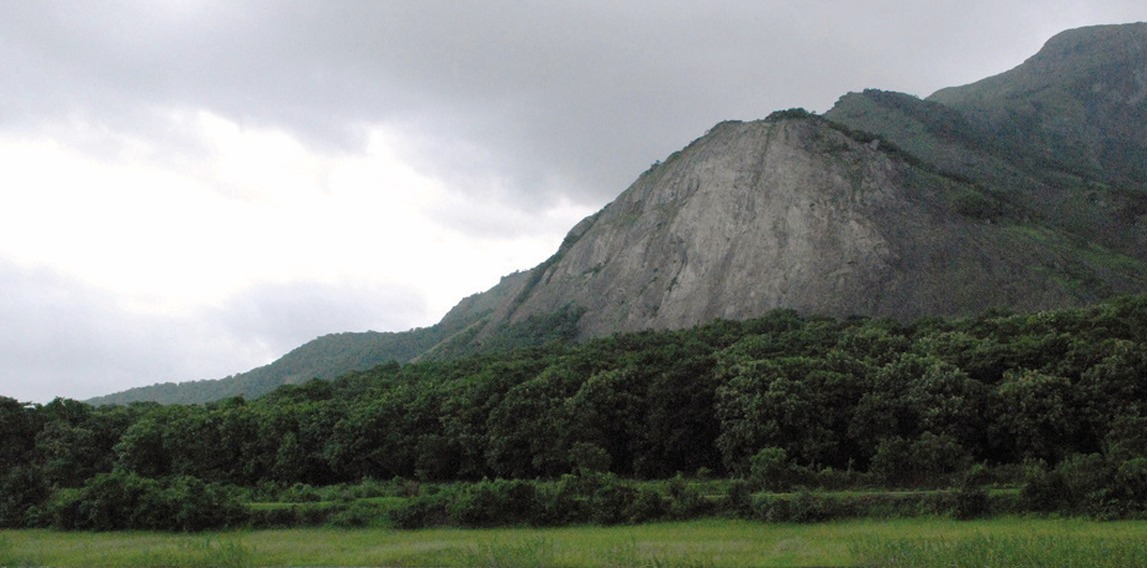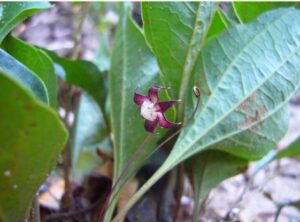The death of tribesman Kuttimathan Kani has rekindled an uncomfortable question: Did the Kani tribe, custodians of this priceless indigenous knowledge, ever truly benefit from their discovery?
Published Sep 01, 2025 | 9:00 AM ⚊ Updated Sep 26, 2025 | 11:27 AM

Arogyapacha is endemic to the Western Ghats. (UNDP)
Synopsis: The death of Kuttimathan Kani has once again brought to the fore a broken promise and exploitation of a tribal community, which introduced the world to Arogyapacha, Kerala’s miracle plant.
A week ago, 72-year-old Kuttimathan Kani lost his battle with cancer. With his passing, a living link to one of Kerala’s most fascinating medicinal legacies slipped into history.
Along with his fellow tribesmen, Mallan Kani and the late Eechan Kani, Kuttimathan had introduced the world to Trichopus zeylanicus travancoricus — locally called Arogyapacha —, the so-called “wonder herb” of the Western Ghats that once promised to revolutionise modern medicine.
But as tributes pour in, his death on 23 August has also rekindled an uncomfortable question: Did the Kani tribe, custodians of this priceless indigenous knowledge, ever truly benefit from their discovery?
The bleak state of the Kerala Kani Community Welfare Trust suggests otherwise — a tale of broken promises, bureaucratic neglect, and exploitation that continues to haunt the community.
In the late 1980s, the indigenous Kani tribe of Kerala’s Agasthyamala came under global spotlight for their traditional use of a unique medicinal plant, Arogyapacha, the miracle plant of tribal healers.

Arogyapacha.
Known among the Kani for its anti-fatigue and revitalising properties, the plant was consumed by tribal members during long treks in the dense forests of the Western Ghats.
The turning point came in December 1987, when Dr. Palpu Pushpangadan, then the director of the Jawaharlal Nehru Tropical Botanical Garden and Research Institute (JNTBGRI), led an ethnobotanical survey team under the All India Coordinated Research Project on Ethnobiology (AICRPE).
Guided by Kani tribesmen, the researchers were struck by the remarkable stamina of their guides.
After observing them chewing small black fruits during the journey, the scientists tasted the fruit themselves and instantly experienced renewed energy. Reluctantly, and only after much persuasion, the Kani guides revealed the source — Arogyapacha, a plant endemic to the Western Ghats.
The Kani community had preserved medicinal knowledge through their tribal physicians, or Plathis, who were custodians of such traditions.
With rigorous phytochemical, pharmacological, and toxicological studies, JNTBGRI researchers confirmed the plant’s anti-stress and immuno-boosting properties. This led to the development of Jeevani, a herbal formulation later licensed to the Arya Vaidya Pharmacy (AVP) for commercial production.
It was then stated that in the formulation, only about 13–15% of it comes from Arogyappacha, while the rest combines other potent Ayurvedic ingredients.
The formulation includes Ashwagandha (known as Indian ginseng and winter cherry) for immunity and vitality, shankhpushpam (blue pea flowers) for memory and calmness, and pippali (long pepper) for metabolic balance and reproductive health, along with approved natural binders and preservatives.
The agreement granted AVP a seven-year licence, with a ₹10 lakh fee and a two percent royalty on sales. These revenues were to be shared equally between JNTBGRI and the Kani community.
However, compensation issues soon arose as the initial benefit-sharing arrangement included only one Kani group, leading to resentment among other settlements.
To address disputes and ensure equitable benefit-sharing, the Kerala Kani Samudaya Kshema Trust, or the Kerala Kani Community Welfare Trust, was formed in 1997.

Kuttimathan Kani.
The Trust included representatives from 30 Kani settlements and was tasked with managing community welfare initiatives while ensuring sustainable harvesting of Arogyapacha.
The Trust also garnered international attention in 2002, when it was presented with the Equator Prize, awarded annually by the United Nations Development Programme, for the benefit-sharing agreement. The UNDP noted that the agreement was “an example of equitably sharing the benefits arising from the sustainable use of genetic resources, one of the three objectives of the Convention on Biological Diversity (CBD)”.
Representing the Trust, it was Kuttimathan who accepted the award at a function organized in Johannesburg, South Africa.
Though royalty payments dwindled after 2005, the Arogyapacha episode remains a landmark in recognising indigenous knowledge systems and establishing models of community benefit-sharing in India.
It marked the first attempt to link tribal traditional knowledge with modern intellectual property rights and community development.
By the early 2000s, what began as a celebrated experiment in benefit-sharing between scientists and the Kani tribe over Arogyappacha (the plant behind the herbal drug Jeevani) had turned into a controversy riddled with distrust and broken promises.
While the JNTBGRI pledged that the Kanis would receive a fair share of profits, the community alleged exclusion from decision-making, patents, and the very research process that capitalised on their traditional knowledge.
A royalty deal of just two percent—far lower than international standards such as Yellowstone National Park’s 10 percent—exposed the weak bargaining position of the Kanis.
Adding to the discontent, internal divisions emerged within the tribe over whether sacred knowledge should have been commercialised at all. Although the Trust was set up, money never reached the people, sparking years of protests and petitions.
Meanwhile, bureaucratic failures—like the non-renewal of patents, a lapsed licence agreement with AVP, and restrictions imposed by the Forest Department on plant collection—meant Jeevani’s production collapsed, leaving scientists, pharma partners, and most painfully, the Kanis, as losers in what was once hailed as a pioneering model of equitable bio-prospecting.
Speaking to South First, Sreedevi Suresh S, vice-president of the Trust and member of Chonampara ward of Kuttichal Grama Panchayat, painted a bleak picture of the once-celebrated initiative.
“The Trust is still active—we do meet occasionally, and there remains genuine enthusiasm among researchers about Arogyapacha. We continue to facilitate research with JNTBGRI, and even now, we provide plant specimens for documentation and study. But the cultivation and collection of Arogyapacha for medicinal production have completely stopped. For some time now, no one has come forward to procure the raw material from us. Earlier, we had a tie-up with Arya Vaidya Pharmacy and received some payments, but that arrangement no longer exists. Today, the Trust has no resources and runs on a zero balance,” she said.
The vice-president also highlighted how old wounds continue to fester.
“The controversy over the Equator Award in 2002 is still unresolved. Back then, our president, Kuttimathan Kani, went to South Africa to receive the award, accompanied by officials from JNTBGRI. The award carried prize money, but one of the officials gave his own bank account number, and the amount was diverted. Though the Trust lodged complaints, nothing has happened to this day,” she alleged.
According to her, the community once saw Arogyapacha as a model for revenue generation, but with no procurement channels, it has been reduced to small-scale cultivation at households, strictly for personal use.
“The plant has unique qualities—those growing in the Agasthyamala Hills are far superior in medicinal properties compared to those outside. People here still grow it in their compounds, but only for their own needs,” she added.
The Trust, headquartered at Chonampara, currently has a nine-member administrative committee.
At the time of its formation, Kuttimathan Kani, with Mallan Kani and Eechan Kani, were inducted as lifelong members.
When asked about the committee’s current plans, Sreedevi said: “Each administrative committee has its own goals. Ours include establishing a production plant and providing employment to the Kani community. But with zero balance in the Trust, we are only holding on to hopes for revival.”
The rise and fall of Arogyapacha is no longer just the story of a medicinal plant — it is the story of how an entire community’s knowledge was mined, celebrated, and then abandoned.
For the Kanis, what began as hope for dignity and development has ended in a zero-balance Trust, bitter memories, and a herb now reduced to household use.
As Kuttimathan Kani is laid to rest, the larger question lingers: Will the world only remember the wonder of Arogyapacha, or will it also confront the injustice of leaving its keepers behind?
(Edited by Majnu Babu).
